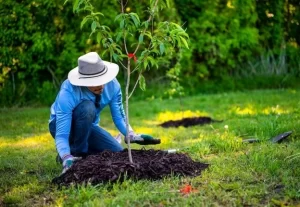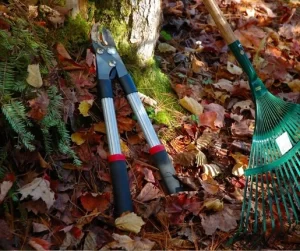Getting your yard ready at the end of summer sets the stage for a robust, disease-resistant landscape that thrives through fall and winter. With a well-planned early fall yard cleanup, you can tackle challenges like fallen leaves, overgrown shrubs, compacted soil, and fading garden beds—turning them into opportunities for healthier lawns and stronger plants. In this guide, you will discover: landscape design services.
- The ideal timing for fall cleanup in our region
- A detailed checklist of essential yard tasks
- Lawn preparation techniques including aeration, overseeding, and fertilization
- Steps to winterize garden beds, shrubs, perennials, and vegetable patches
- Tool care, gutter cleaning, and patio winterization
- Benefits of professional services from Hawkins Landscaping
- Clear answers to common homeowner concerns
By following these steps, you’ll achieve a fall-ready landscape that preserves moisture, prevents pests, and promotes vigorous spring growth.

When Is the Best Time to Start Your Early Fall Yard Cleanup?
Late August through early October provides the optimal window for early fall yard cleanup, allowing plants to recover before frost while preventing pest and disease buildup. This timing improves root establishment for seeded areas, curbs fungal growth under fallen leaves, and prepares irrigation systems for winter shutoff. Aligning cleanup tasks with local climate patterns ensures maximum benefit.
Knowing the right window leads us to the specific months that work best in our region and how timing affects overall lawn and garden health.
What Are the Ideal Months for Fall Yard Cleanup in Our Region?
Fall cleanup in our service area typically falls between mid-September and mid-October, when daytime temperatures average 60–75°F and soil moisture remains moderate. Scheduling during these weeks maximizes leaf removal before heavy precipitation and allows shrubs to finish minor growth toward dormancy. This window balances warm soil for root activity with cooler air that reduces heat stress.
Leaves and debris cleared during this period promote healthier turf and set the stage for overseeding, pruning, and mulching before the first frost.
How Does Timing Affect Lawn and Garden Health?
Proper fall cleanup timing improves root development, reduces thatch buildup, and prevents overwintering pests from sheltering under leaves. Early leaf removal enhances sunlight penetration and air circulation, while punctual aeration and overseeding foster root extension before winter dormancy. Delaying tasks risks soil compaction and disease proliferation, which undermines spring vigor and increases maintenance costs.
Optimizing timing sets the foundation for the essential tasks detailed next.
When Should Homeowners Schedule Professional Fall Cleanup Services?
Homeowners seeking expert leaf removal, pruning, aeration, and mulching should book professional services in early September. Hawkins Landscaping’s certified crews plan around local climate data to secure ideal conditions and avoid end-of-season scheduling conflicts. Early booking ensures access to specialized equipment such as core aerators, wood-chipper trucks, and frost-rated mulching materials.
Aligning service dates with peak cleanup windows guarantees improved results and saves homeowners time and effort.
What Are the Essential Tasks in an Early Fall Yard Cleanup Checklist?
An early fall yard cleanup is a collection of interrelated tasks that restore order and prepare your landscape for winter. Each activity promotes plant health, soil structure, and curb appeal when executed in sequence.
Task | Purpose | Benefit |
|---|---|---|
Leaf Removal | Clears fallen foliage | Prevents lawn suffocation and fungus |
Pruning Shrubs & Trees | Removes dead wood | Reduces disease risk and encourages new growth |
Lawn Aeration & Overseeding | Loosens compaction | Improves nutrient uptake and thickens turf |
Mulching Garden Beds | Insulates soil | Preserves moisture and protects roots |
Garden Bed Debris Cleanup | Removes spent growth | Limits pests and disease reservoirs |
Why Is Leaf Removal Critical for a Healthy Lawn?
Leaf removal is one of the most important steps in your early fall yard cleanup. It prevents a dense mat of debris that blocks sunlight, traps moisture, and encourages mold growth. Raking, blowing, or mulching leaves ensures grass blades receive air and light, which reduces brown patch disease and accelerates decomposition into nutrient-rich mulch. Removing leaves also uncovers potential pest habitats, making early intervention possible.
Consistent leaf clearing supports the next steps in your cleanup sequence, including aeration and fertilization.
How to Properly Prune Shrubs and Trees for Fall?
Pruning in fall involves removing dead, diseased, or crossing branches to minimize winter damage and promote structural strength. First, inspect each plant for weak limbs and cutting them at the branch collar prevents damage to the trunk. Second, thin interior growth to improve air circulation, targeting no more than 25% removal per session. Finally, seal large cuts with an approved arborist dressing to guard against moisture intrusion.
Effective fall pruning reduces spring maintenance and boosts resilience against winter storms.
What Are the Benefits of Lawn Aeration and Overseeding in Autumn?
Core lawn aeration uses specialized tines to extract soil plugs, relieving compaction and increasing oxygen, water, and nutrient access to grassroots. Following aeration with overseeding deposits fresh seed into open cores, improving turf density and crowding out weeds.
Maintenance Step | Immediate Effect | Long-Term Result |
|---|---|---|
Aeration | Creates pores in soil | Enhanced drainage and root depth |
Overseeding | Introduces new grass varieties | Uniform turf cover and disease resistance |
Combining these processes late in the growing season allows seedlings to establish robust roots before winter dormancy.
Smith, J., Journal of Turf Management (2022)
The Benefits of Lawn Aeration and Overseeding
Lawn aeration and overseeding are essential practices for maintaining a healthy lawn. Aeration helps to reduce soil compaction, allowing for better water and nutrient absorption, while overseeding helps to fill in bare spots and thicken the turf, leading to a more resilient lawn that is better able to withstand environmental stressors.
This research supports the article’s recommendations for lawn aeration and overseeding, highlighting their importance for lawn health and resilience.
How Does Mulching Protect Your Garden Beds for Winter?
Applying a 2–4 inch layer of organic mulch acts as insulation, moderating soil temperature fluctuations that can damage roots. Mulch composed of shredded leaves, wood chips, or compost absorbs and releases moisture slowly, preventing soil heaving caused by freeze-thaw cycles. Added organic matter enriches soil biology, fostering beneficial microbes and earthworms.
Brown, A., Horticultural Science Journal (2023)
The Importance of Mulching in Garden Beds
Mulching garden beds is a beneficial practice that helps to regulate soil temperature, conserve moisture, and suppress weed growth. Organic mulches, such as shredded leaves or wood chips, also improve soil structure and fertility as they decompose, creating a healthier environment for plant roots.
This citation supports the article’s emphasis on the benefits of mulching for garden bed health and winterization.
Protecting beds with mulch lessens spring cleanup and promotes earlier bud break on perennials.
Why Is Debris and Garden Bed Cleanup Important Before Winter?
Removing spent annuals, fallen fruit, and diseased plant material prevents pests and pathogens from overwintering. Clearing out old crop residues in vegetable plots reduces fungal inoculum, while clearing under shrubs limits scale insects and caterpillar egg clusters. This proactive cleanup minimizes startup pests and diseases when growth resumes in spring.
Thorough debris removal sets the stage for garden bed preparation covered next.
How Do You Prepare Your Lawn for Fall and Winter?
An early fall yard cleanup is the foundation for effective lawn preparation before the cold months arrive. This phase integrates fertilization, aeration, overseeding, and weed control to strengthen roots and ward off winter stress. Performing these tasks in sequence maximizes nutrient uptake and seed germination rates, setting your lawn up for lush, green growth in spring.
What Is the Best Fall Fertilization Strategy for Lawns?
A specialized autumn fertilizer contains higher phosphorus and potassium to support root development and disease resistance, with moderate nitrogen to avoid excessive top growth. Organic options such as bone meal or composted manure release nutrients gradually, enhancing soil structure and microbial health. Applying fertilizer immediately after aeration locks in nutrients around exposed roots for optimal absorption.
Balanced late-season feeding yields thicker turf that resists winter strain and emerges vigorously in spring — one of the core goals of a well-planned early fall yard cleanup.
How Does Lawn Aeration Improve Soil and Grass Health?
Aerating alleviates compaction caused by summer foot traffic and mowing, creating channels that let water and oxygen penetrate deeper into soil layers. Improved aeration enhances microbial activity and root expansion, promoting drought tolerance and nutrient efficiency. Core removal also provides seed-bed cavities for overseeding to fill thin spots.
Regular autumn aeration preserves soil structure and builds resilience against winter wetness, improving overall lawn vitality.
When and How Should You Overseed Your Lawn in Fall?
Overseeding soon after aeration—in late September to early October—takes advantage of warm soil and cooler nights that encourage seed germination without weed competition. Use a high-quality seed blend matched to your existing turf and broadcast evenly with a drop spreader. Lightly rake seeds into aeration holes and water daily until new grass reaches one inch.
This approach yields a dense stand that crowds out weeds and reduces erosion from winter runoff.
Should You Apply Weed Control During Fall Cleanup?
Targeted post-emergent herbicides can eliminate stubborn broadleaf weeds late in the season without harming root development, especially when combined with overseeding. Alternatively, organic weed-and-feed products use corn gluten meal to suppress seed germination and provide gentle fertilization. Applying weed control after aeration and before overseeding maximizes coverage of bare soil.
Integrating weed management as part of your early fall yard cleanup ensures fewer spring dandelions and clover infestations, while helping your lawn transition into dormancy strong and healthy.
How Should Garden Beds and Plants Be Prepared for Winter?
An early fall yard cleanup plays a crucial role in winterizing garden beds and woody plants through dormancy pruning, frost protection, and soil enrichment. These steps help support plant health, prevent damage, and maintain strong root systems throughout the cold season.
What Are the Best Practices for Fall Pruning of Shrubs and Trees?
Dormant pruning targets dead or crossing branches when sap flow slows, reducing stress and preventing pathogen entry. Start by sterilizing shears between cuts on different plants to avoid disease spread. Remove suckers and water sprouts at their base, then thin the canopy by cutting back to lateral branches at a 45° angle. Pruning in fall shapes the plant for spring flowering and eases snow load stress.
Clean cuts heal more effectively when made before sap starts to rise, making pruning an important follow-up task after your early fall yard cleanup routine.
How Can You Protect Perennials from Frost Damage?
Cover perennials with frost blankets or burlap once nighttime temperatures consistently drop below 28°F. Mounding a small layer of mulch around crowns insulates root bases and prevents freeze-thaw heaving. For shallow-rooted varieties, apply an insulating mulch ring 6–8 inches wide and replenish as needed. Remove covers on sunny days to avoid overheating and moisture buildup.
This proactive frost protection step complements the benefits of your early fall yard cleanup, preserving crown tissues for healthy spring regrowth.
What Steps Are Needed for End-of-Season Vegetable Garden Cleanup?
Clearing spent tomato vines, pepper stalks, and legume vines removes overwintering insect eggs and soil-borne pathogens. Compost healthy green debris and discard diseased material away from garden beds. Rotate crop families to new plots to break pest cycles and apply a cover crop such as winter rye to fix nitrogen and prevent erosion. Tilling composted amendments into soil in early fall boosts fertility for spring planting.
Vegetable garden cleanup is another essential phase of early fall yard cleanup, simplifying spring prep and improving next season’s yields.
How Does Mulching Enhance Garden Bed Winterization?
Applying mulch after debris removal seals insulation over prepared beds, protecting roots and soil structure. Organic materials such as straw or pine needles decompose slowly, maintaining wintertime airflow while suppressing weeds. Mulch also prevents soil crusting under rain and snow, preserving oxygen pockets essential for root respiration.
Effective bed winterization with mulch reduces spring erosion and jump-starts soil biology, completing one of the most rewarding stages of your early fall yard cleanup.
What General Yard Maintenance and Tool Care Are Needed for Fall?
An early fall yard cleanup isn’t just about tending to plants—it also includes essential maintenance tasks like gutter clearing, tool care, and preparing patios or decks for winter weather. Addressing these details protects your landscape investments and prevents costly spring repairs.
Why Is Fall Gutter Cleaning Important for Yard Health?
Clearing gutters and downspouts ensures proper drainage away from foundations and landscape beds, preventing soil erosion, waterlogging, and root damage. Removing leaves and debris from channels reduces ice dam formation in cold weather. Installing gutter guards during cleanup expedites future maintenance and protects planting beds below.
Reliable drainage supports the overall success of your early fall yard cleanup, maintaining healthy soil structure and preventing mold growth in landscape areas.
How Should Garden Tools Be Maintained and Stored for Winter?
Before storage, clean blades and tines with a wire brush to remove sap and dirt, then wipe them with oil to prevent rust. Sharpen pruning shears and hedge trimmer blades for precise cuts next season. Drain fuel from power tools and add stabilizer if storage is unavoidable. Store hand tools in a dry, well-ventilated space and hang them to preserve handle integrity.
Including tool maintenance in your early fall yard cleanup ensures you start the next season fully prepared, with equipment ready to perform efficiently.
What Are the Best Practices for Patio and Deck Winterization?
Clean and seal wood decks with a water-repellent finish to prevent moisture penetration and freeze damage. Inspect and repair loose boards, rails, and pavers to avoid warping. Store outdoor furniture indoors or cover securely with breathable weatherproof tarps to protect cushions and metal frames. Sweep away leaves and debris that retain moisture against surfaces.
Preparing decks and patios for winter preserves structural integrity and reduces spring repair needs.
Why Choose Professional Fall Yard Cleanup Services from Hawkins Landscaping?

Hiring experienced professionals for your early fall yard cleanup ensures a thorough, efficient process that maximizes plant health and landscape longevity.
Hawkins Landscaping, a family-owned business since 1974, offers certified technicians, advanced equipment, and tailored seasonal programs that deliver consistent, high-quality results. With over 40 years of service in our community, we combine local climate expertise with sustainable practices.
How Does Hawkins Landscaping Perform Expert Leaf Removal and Mulching?
Our team uses commercial leaf blowers, dedicated vacuums, and high-capacity wood chippers to remove and recycle foliage into premium mulch. Technicians distribute shredded material in garden beds to insulate roots and enrich soil biology. This integrated approach prevents compaction and fosters beneficial microbial activity under cover of mulch.
By turning waste into resource, we support a circular mulch process that benefits your landscape and the environment.
What Are the Benefits of Hiring Certified Landscapers for Fall Cleanup?
Certified landscapers bring specialized training in plant health, pruning biology, and soil science that goes beyond basic yard work. Their proficiency in equipment calibration ensures precise aeration depths and accurate fertilizer application. As locally licensed professionals, they adhere to regional regulations on waste disposal and environmentally responsible product use, safeguarding both plants and groundwater.
Expert oversight reduces mistakes, prevents unnecessary plant loss, and protects long-term landscape value. Hiring Hawkins Landscaping for your early fall yard cleanup means gaining expert precision, time savings, and peace of mind that every task is handled correctly.
How Does Professional Lawn Aeration and Fertilization Improve Results?
Our core aerators deliver uniform soil penetration while capturing plugs for removal. Right after aeration, we apply custom fertilizer blends formulated for autumn root growth and disease suppression. This coordinated timing enhances nutrient uptake directly in the root zone, promoting uniform germination and stronger, more resilient turf.
Professional application minimizes waste, prevents over-application, and yields denser, greener lawns with fewer bare patches.
What Local Case Studies Showcase Hawkins Landscaping’s Fall Cleanup Success?
In Frederick County, we revitalized a historic lawn by removing four truckloads of leaves, aerating high-traffic areas, and overseeding native turf varieties—resulting in a 35% increase in grass density the following spring. In Montgomery County, targeted pruning and mulching of ornamental plantings reduced winter limb damage by 60% year-over-year. Client testimonials praise our timely scheduling, neat work ethic, and lasting landscape improvements.
What Are Common Questions About Fall Yard Cleanup?
Homeowners often wonder how frequently to tackle end-of-season tasks, whether DIY methods suffice, and how organic options impact environmental health and pest control. Below are clear, actionable explanations to guide your early fall yard cleanup planning.
How Often Should Fall Cleanup Be Performed Each Year?
Fall cleanup should be performed once annually, ideally during the window from mid-September to mid-October. Consistent yearly attention prevents debris buildup and supports continuous soil health. In climates with extended leaf drop, a secondary light leaf clearing in late October helps maintain optimal sunlight and airflow.
Annual early fall yard cleanup establishes a strong maintenance baseline that simplifies spring preparation and reduces disease pressure.
Can Homeowners Do Fall Cleanup Themselves or Should They Hire Professionals?
DIY cleanup is possible using basic tools like rakes, shears, and walk-behind aerators, but professional services deliver faster results with specialized equipment and horticultural expertise. Homeowners with time constraints or large properties benefit from hiring certified teams that ensure precise pruning, uniform aeration, and correct mulching depths for maximum plant protection.
Choosing professional help frees your schedule and leverages proven methods for reliable, long-term landscape success.
What Are the Environmental Benefits of Organic Fall Lawn Care?
Organic fertilizers and mulches release nutrients slowly, reducing runoff and protecting nearby waterways. Compost-based amendments build soil structure, increase carbon sequestration, and foster beneficial microorganisms. Avoiding synthetic herbicides promotes pollinator health and prevents chemical resistance in weed populations.
Implementing organic practices as part of your early fall yard cleanup aligns your landscape care with sustainable stewardship and healthy ecosystem support.
How Does Fall Cleanup Prevent Pests and Lawn Diseases?
Removing leaf litter and debris eliminates overwintering habitats for ticks, slugs, and fungal spores. Aeration reduces soil compaction that encourages root rot, while proper fertilization builds root strength to resist pathogens. Mulching and pruning further discourage rodent nesting and scattered fungal growth, creating a cleaner environment for spring emergence.
A comprehensive early fall yard cleanup interrupts pest cycles and significantly lowers the risk of disease outbreaks next season.
Preparing your yard at summer’s end cultivates a strong foundation for plant health, water management, and aesthetic appeal throughout fall and winter. Following this systematic approach ensures that lawns breathe freely, garden beds remain insulated, and outdoor structures stand ready for colder months.
Professional services from Hawkins Landscaping bring local expertise, advanced equipment, and proven techniques to save you time and deliver superior results.
Embrace these strategies now to enjoy a vibrant, resilient landscape come spring. Contact Hawkins Landscaping today to schedule your early fall yard cleanup!
About Us
Founded in 1974, Hawkins Landscaping Inc. has grown into one of Maryland’s most trusted names in residential and commercial landscaping. We specialize in creating and maintaining outdoor spaces that are both functional and beautiful—from hardscaping and drainage solutions to early fall yard cleanup, lawn care, and custom landscape design. Our team is committed to quality craftsmanship, customer satisfaction, and helping you enjoy your yard year-round.




